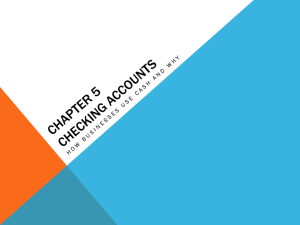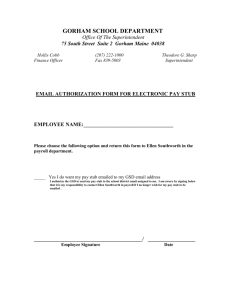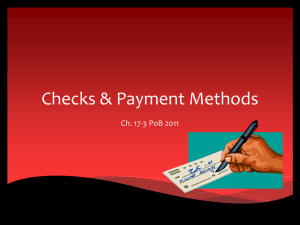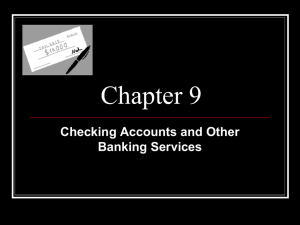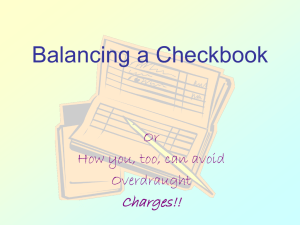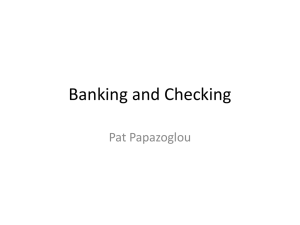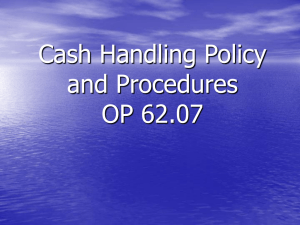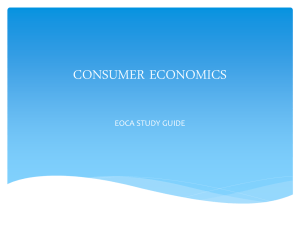Slides Chpt 11
advertisement
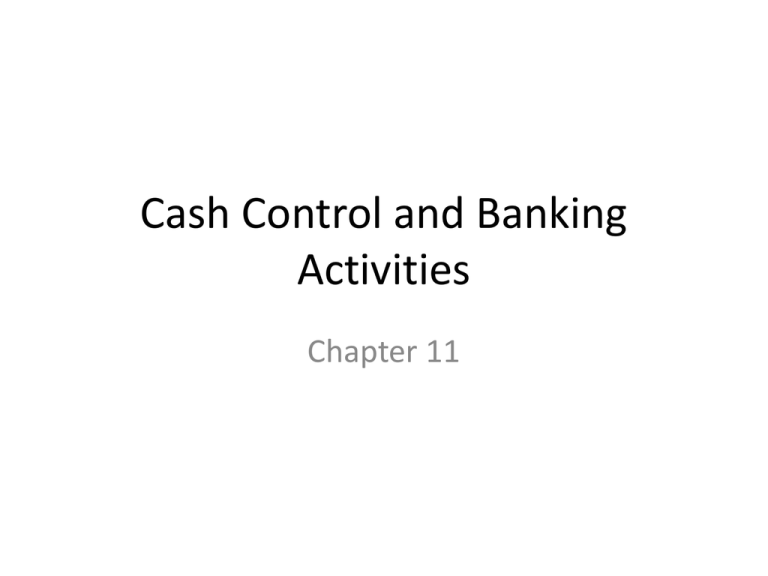
Cash Control and Banking Activities Chapter 11 Protecting Cash Pg 278 • Cash dangers are ever present: loss, waste, theft, forgery, and embezzlement • Internal Control Protection 1. Limiting the number of persons handling cash 2. Separating accounting tasks involving cash (receipt, payments, records) 3. Bonding (insuring) employees who handle cash or cash records 4. Using a cash register and a safe 5. Depositing cash in the bank daily 6. Making all cash payments by check 7. Reconciling the bank statement • External Control Protection – the measures and procedures provided outside the business to protect cash and other assets. Ex. Banking controls The Checking Account • A checking account allows a person or business to deposit cash/checks in a bank and to write checks against the account balance. • A check is a written order from a depositor telling the bank to pay a stated amount of cash to the person or business named on the check • A depositor is a person or business that has cash on deposit in a bank (account holder) Pg 278 Opening a Checking Account • *Shop around to find an account that fits your needs and that is affordable • Signature Card – all new account holders are required to sign a signature card. It contains the signatures of the person(s) authorized to write checks on the account. It is used to compare signatures on checks if there is a question of fraud – *The signature card also acts as your contract with the bank as to your personal information and your agreement to follow the rules of the account Pg 279 Checks • The Checkbook – Using checks with preprinted numbers helps a business keep track of every check that is written • The ABA Number – On all preprinted checks is a MICR encoded number at the top and bottom of each check. It identifies the bank the account is drawn off of and allows for electronic processing of checks to speed the process Pg 279 Making Deposits • A business makes regular deposits to protect the currency, coins and checks it receives. • Deposit Slips are made and given to the bank along with the items being deposited. It details what is being deposited, number of items, and amounts. (another way to control cash flow) • Deposit slips consist of 1. 2. 3. 4. The Date The amount of Cash A list of Checks A total for the deposit Endorsing Checks • Endorsement is an authorized signature written or stamped on the back of a check that transfers ownership of the check. • A business can use 3 types of endorsements 1. 2. 3. • Blank Endorsement – includes only the signature or stamp of the depositor. It transfers ownership of the check, but it doesn’t not indicate who the new owner is. This is not a safe endorsement because the check can be cashed by anyone who presents it for payment. Special Endorsement – transfers ownership of the check to a specific person or business Restrictive Endorsement – transfers ownership to a specific owner and then limits, or restricts, how a check may be handled even after ownership is transferred. To protect checks being cashed by anyone else, Roadrunner uses a restrictive endorsement that reads “For Deposit Only”. It is stamped on the back of each check as soon as it is received. 3 Endorsements Pg 281 Recording Deposits • The check stubs in the check book are a record of the Cash In Bank account. The completed stub reflects all checking account transactions: payments, deposits, and bank service charges • Process of recording deposits: Pg 281 1. Enter the date of the deposit on the check stub of the next unused check on the deposit line 2. Enter the total amount of the deposit on the same line in the dollars and cents column 3. Add the deposit amounts to the amount on the Balance Brought Forward line and put that amount on the Total line. This is the new checkbook balance. Writing Checks • Always write checks in ink • Always fill out a check completely • Complete the check stub BEFORE writing the check – Because the stub serves as a permanent record of the check, it must be complete and accurate – The top of the check stub is dedicated for information about the check being written – The bottom of the check stub is for keeping track of current balance and deposits made to the account Parts of a Check • Date – This is the date you write the check – Post dating is writing a check and dating for a day in the future. Banks do not have to honor the post date. Once a check is signed, it is valid and can be processed. • Payee – The Pay To The Order Of line – This is where the account holder designates who has the rights to the amount on the check • Number Amount – The amount of the check signified in numeric fashion • Legal Line – The amount of the check written out in words. *If there is a difference between the number amount and the legal line, the bank is obligated to take the amount written on the legal line. • Memo Line – This is an optional space for keeping track of notations about the check • Signature Line – Where the account holder signs their name authorizing the bank to pay the amount on the check to the payee. • Drawer – the person who signs the check • Drawee – the person who the check is written to Pg 282 Check and Check Stub Pg 282 Voiding A Check • If an error is made while writing a check, the check is marked “Void” in large letters across the front (in ink). The check then cannot be used but is still maintained for record keeping purposes. Never throw away a voided check. • When a check is voided, the stub is also voided Pg 282 Proving Cash • Proving Cash – The balance in the Cash in Bank account in the general ledger is regularly compared with the balance in the checkbook. – This is part of internal control and will give an early indication if something is wrong – Accountants must take into consideration: outstanding checks, outstanding deposits, and bank fees *Outstanding means not yet received *Bank fees/service charges – Usually charged to the account once a month based on the rules of the particular account Finding and Correcting Errors • Possible errors – Faulty addition and/or subtraction – Failure to record a check or deposit – Mistake in copying the balance forward amount to the next check stub • Correcting errors – If the error is in the checkbook, make the correction on the next unused check stub • Make notations on both the original check stub with the error as to where the correction is made and then on the correction is made on the indicated check stub The Bank Statement • Bank Statement – an itemized record of all transactions in a depositor’s account over a given period-usually a month. – Checking account balance at the beginning of the period – List of all deposits made during the period – List of all checks paid by the bank during the period – List of any other deductions from the depositor’s account – Checking account balance at the end of the period You get… • Canceled Checks – The actual check you wrote that has been processed by the bank and stamped Canceled. It can act as proof of purchase/payment • Imaged Checks (Truncated) – copies of the original check, usually printed smaller and several to a page Pg 285 Reconciliation Form • Also known as a reconciling the bank statement. • A worksheet (usually printed on the back of the bank statement) that the account holder uses to make sure their books and the banks records match. • The reconciliation form only has those transactions on it that have passed through the banks processing system. The user needs to account for outstanding items • The reconciliation will include information not previously available to the account holder and must be added/subtracted to the business’ books – Service Fees – Interest Earned Pg 285 Pg 285 Pg 287 Journalizing Service Charges • Fees are a part of doing business and must be accounted for as an expense. If fees are nominal, most businesses account for them in a Miscellaneous Expense account • Earning Interest – If a business has an account where they earn interest, they will have an account set up to account for what they earn. Pg 286 Special Banking Procedures • Stop Payment on a Check – revokes the bank’s order to pay the payee of the check. – Usually has a substantial fee so this should not be done lightly Pg 289 Special Banking Procedures • Recording NSF Checks – Non Sufficient Funds (dishonored or bounced check) – this is when a check cannot be covered by the funds available in the account – If your business bounces a check, you will sustain a large fee and risk a report to your credit company and/or the bank closing your account – If your business deposits a check that is returned for non-sufficient funds then you must make note on the next unused check stub and subtract the amount from the current balance in the account Electronic Funds Transfer System • Known as EFT or EFTS • These are electronic transfers of money from one account to another without the use of a paper document – – – – – – Direct Payroll Deposit Automated Bill Payments Bankcards Automated Teller Machines (ATMs) Bank by Phone Online Banking • Businesses that use EFTs should have procedures in place for keeping track of and recording these activities EFT Journal Transaction Pg 290
